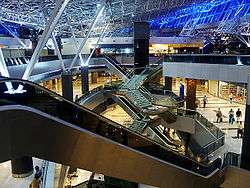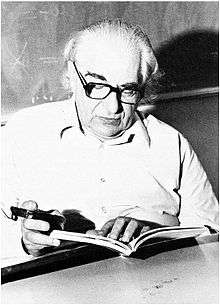Recife
| Recife | |||
|---|---|---|---|
| Municipality | |||
| The Municipality of Recife | |||
|
From upper left: Old centre of Recife; Recife and its bridges; Aerial View of Boa Viagem Beach; Boa Viagem Beach; The Crystal Tower; Capibaribe River; The neighborhood of Boa Viagem; Agamenon Magalhães Avenue; Recife Sunset. | |||
| |||
| Nickname(s): Veneza Brasileira (Brazilian Venice), Capital of the Northeast and Mauricéia/Mauritsstad (after the Dutch colonisation) | |||
|
Motto: Latin: "Ut Luceat Omnibus"' "That it may shine on all" (Matthew 5:15) | |||
 Recife Location in Brazil | |||
| Coordinates: 8°3′S 34°54′W / 8.050°S 34.900°WCoordinates: 8°3′S 34°54′W / 8.050°S 34.900°W | |||
| Country |
| ||
| Region | Northeast | ||
| State |
| ||
| Founded | March 12, 1537 | ||
| Incorporated (as village) | 1709 | ||
| Incorporated (as city) | 1823 | ||
| Government | |||
| • Mayor | Geraldo Júlio de Mello Filho (Geraldo Júlio) (PSB) | ||
| Area | |||
| • Municipality | 218 km2 (84.17 sq mi) | ||
| • Metro | 2,768 km2 (1,068.7 sq mi) | ||
| Elevation | 10 m (33 ft) | ||
| Population (2012) | |||
| • Municipality | 1,555,039 (9th) | ||
| • Density | 7,133.2/km2 (18,537.9/sq mi) | ||
| • Metro | 3,743,854(6th) | ||
| • Metro density | 1,352.5/km2 (3,527/sq mi) | ||
| Demonym(s) | Recifense | ||
| Time zone | UTC-3 (UTC-3) | ||
| Postal Code | 50000-000 | ||
| Area code(s) | +55 81 | ||
| Website |
www | ||
Recife (Portuguese pronunciation: [ʁeˈsifi]) is the sixth-largest[1] metropolitan area in Brazil with 3,743,854 inhabitants, the largest metropolitan area of the North/Northeast Regions, the sixth largest metropolitan influence area in Brazil, and the capital and largest city of the state of Pernambuco. The population of the city proper was 1,555,039 in 2012.[2]
The former capital of the 17th century Dutch Brazil, Recife was founded in 1537, during the early Portuguese colonization of Brazil, as the main harbor of the Captaincy of Pernambuco, known for its large scale production of sugar cane. The city is located at the confluence of the Beberibe and Capibaribe rivers before they flow into the Atlantic Ocean. It is a major port on the Atlantic Ocean. Its name is an allusion to the stone reefs that are present by the city's shores. The many rivers, small islands and over 50 bridges found in Recife city centre characterise its geography and led to the city being called the "Brazilian Venice". As of 2010, it is the capital city with the highest HDI in Northeast Brazil and second highest HDI in the entire North and Northeast Brazil (second only to Palmas).[3]
The Metropolitan Region of Recife is the main industrial zone of the State of Pernambuco; major products are those derived from cane (sugar and ethanol), ships, oil platforms, electronics, software, and others. With fiscal incentives by the government, many industrial companies were started in the 1970s and 1980s. Recife has a tradition of being the most important commercial hub of the North/Northeastern region of Brazil, with more than 52,500 business enterprises in Recife plus 32,500 in the Metro Area, totaling more than 85,000.[4]
A combination of a large supply of labor and significant private investments turned Recife into Brazil's second largest medical hub (second only to São Paulo);[5] modern hospitals with state-of-the-art equipment receive patients from several neighbouring States.[6][7]
Recife stands out as a major tourist attraction of the Northeast, both for its beaches and for its historic sites, dating back to both the Portuguese and the Dutch colonization of the region. The beach of Porto de Galinhas, 60 kilometers (37 mi) south of the city, has been repeatedly awarded the title of best beach in Brazil and has drawn many tourists. The Historic Centre of Olinda, 7 kilometers (4.3 mi) north of the city, was declared a UNESCO World Heritage site in 1982, and both cities' Brazilian Carnival are among the world's most famous.
The city is an education hub, and home to the Federal University of Pernambuco, the largest university in Pernambuco. Several Brazilian historical figures, such as the poet and abolitionist Castro Alves, moved to Recife for their studies. Recife and Natal are the only Brazilian cities with direct flights to the islands of Fernando de Noronha, a World Heritage Site.[8]
The city was one of the host cities of the 2014 FIFA World Cup. Additionally, Recife hosted the 2013 FIFA Confederations Cup and the 1950 FIFA World Cup.
History
![]() Portuguese Empire 1537–1815
Portuguese Empire 1537–1815
![]() Dutch West India Company 1630–1654
Dutch West India Company 1630–1654
![]() United Kingdom of PBA 1815–1822
United Kingdom of PBA 1815–1822
![]() Empire of Brazil 1822–1889
Empire of Brazil 1822–1889
![]() Republic of Brazil 1889–present
Republic of Brazil 1889–present

.jpg)
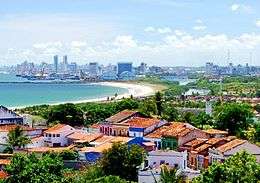
Recife began as a collection of fishing shacks, inns and warehouses on the delta between the Capibaribe and Beberibe Rivers in the captaincy of Pernambuco, sometime between 1535 and 1537 in the earliest days of Portuguese colonisation of Terra de Santa Cruz, later called Brazil, on the northeast coast of South America. It was a settlement of colonial fishermen and way station for Portuguese sailors. The first documented reference to the settlement with its "arrecife dos navios" (reef of the ships) was in the royal Charter Act of March 12, 1537, establishing Olinda, 6 kilometres (3.7 miles) to the north, as a village, with its port where the Beberibe River meets the sea. Olinda (and Igarassu before it) had been settled in 1536 by captain General Duarte Coelho, a Portuguese nobleman, proprietor and administrator of the captaincy of Pernambuco.[9]
The city is named for the long reef recife running parallel to the shoreline which encloses its harbour. The reef is not as sometimes stated, a coral reef, but a consolidated ancient beach, now as firm and hard as stone.[10]
In 1541, Coelho returned from Portugal with the machinery for an engenho (sugarmill), and with it, his brother-in-law established the first mill named Nossa Senhora da Ajuda (Our Lady of Help), in the floodplain of the Beberibe River at Recife. At that time the banks of the Capibaribe River were covered by sugarcane.
Recife was capital of the 17th century Dutch Brazil and was called Mauritsstad.
The Mascate War of 1710-1711 pitted merchants of Recife against those of nearby Olinda.
Geography

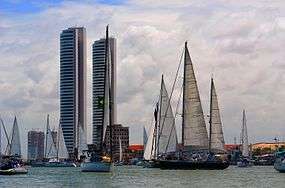
Due to the city's proximity to the equator, Recife weather is generally warm. Recife has a number of islands, rivers, waterways and bridges that crisscross the city. Recife is located amidst tropical forests which are distinguished by high rainfall levels resulting in poor soil quality as the rainfall washes away the nutrients. There is an absence of extreme temperatures and a cool breeze due to the trade winds from the Atlantic Ocean.[11]
Climate
Recife has a tropical climate (As in Köppen climate classification), with warm to hot temperatures and high relative humidity throughout the year. However, these conditions are relieved by pleasant trade winds blowing in from the ocean.[12] Under the Köppen climate classification, the city features a tropical monsoon climate. January and February are the warmest months, with mean temperatures ranging from 30 °C (86 °F) to 22 °C (72 °F), with sun; July is the cloudiest month, experiences the coolest temperatures, with mean temperatures ranging from 27 °C (81 °F) to 21 °C (70 °F), and is the wettest month, receiving an average of 388 mm (15.3 in) of rain.[13][14][15][16] The driest and sunniest month is November, when maximum temperatures hover around 30 °C (86 °F) and an average of 36 mm (1.4 in) of rain is recorded.[16]
| Climate data for Recife (1961–1990) | |||||||||||||
|---|---|---|---|---|---|---|---|---|---|---|---|---|---|
| Month | Jan | Feb | Mar | Apr | May | Jun | Jul | Aug | Sep | Oct | Nov | Dec | Year |
| Record high °C (°F) | 33.1 (91.6) |
32.7 (90.9) |
35.1 (95.2) |
33.3 (91.9) |
31.8 (89.2) |
30.9 (87.6) |
33 (91) |
35.7 (96.3) |
32.7 (90.9) |
33.1 (91.6) |
32.4 (90.3) |
34.5 (94.1) |
35.7 (96.3) |
| Average high °C (°F) | 30.2 (86.4) |
30.2 (86.4) |
30 (86) |
29.7 (85.5) |
28.9 (84) |
27.9 (82.2) |
27.3 (81.1) |
27.5 (81.5) |
28.1 (82.6) |
29 (84) |
30.1 (86.2) |
30.2 (86.4) |
29.1 (84.4) |
| Daily mean °C (°F) | 26.5 (79.7) |
26.5 (79.7) |
26.4 (79.5) |
25.9 (78.6) |
25.2 (77.4) |
24.5 (76.1) |
23.9 (75) |
23.9 (75) |
24.6 (76.3) |
25.5 (77.9) |
26.1 (79) |
26.4 (79.5) |
25.5 (77.9) |
| Average low °C (°F) | 22.4 (72.3) |
22.6 (72.7) |
22.7 (72.9) |
22.6 (72.7) |
21.9 (71.4) |
21.6 (70.9) |
21.1 (70) |
20.6 (69.1) |
20.7 (69.3) |
21.4 (70.5) |
21.9 (71.4) |
22.2 (72) |
21.8 (71.2) |
| Record low °C (°F) | 16.8 (62.2) |
17.8 (64) |
17.9 (64.2) |
19.2 (66.6) |
16.9 (62.4) |
17.1 (62.8) |
16 (61) |
15.3 (59.5) |
15 (59) |
16 (61) |
16.7 (62.1) |
16.4 (61.5) |
15 (59) |
| Average rainfall mm (inches) | 108.2 (4.26) |
148.2 (5.835) |
256.9 (10.114) |
337.6 (13.291) |
318.5 (12.539) |
377.9 (14.878) |
388.1 (15.28) |
204.8 (8.063) |
122 (4.8) |
63 (2.48) |
35.7 (1.406) |
56.8 (2.236) |
2,417.6 (95.181) |
| Average rainy days (≥ 1 mm) | 10 | 11 | 16 | 18 | 20 | 21 | 22 | 17 | 13 | 9 | 6 | 8 | 171 |
| Average relative humidity (%) | 73 | 77 | 80 | 84 | 85 | 85 | 85 | 85 | 78 | 76 | 74 | 75 | 79.8 |
| Mean monthly sunshine hours | 246.3 | 210.8 | 203.9 | 185.2 | 186.3 | 168.3 | 157.6 | 207.1 | 216.6 | 247.3 | 265.8 | 255.2 | 2,550.7 |
| Source: Brazilian National Institute of Meteorology (INMET).[13][14][15][16][17][18][19][20][21] | |||||||||||||
Vegetation
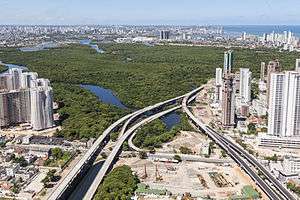
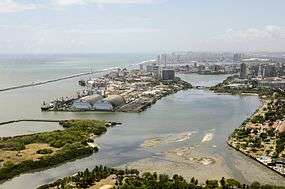
Recife has a tropical forest. Rainforests are characterised by high rainfall, with definitions setting minimum normal annual rainfall between 2,000 millimetres (79 in) and 1,700 millimetres (67 in). The soil can be poor because high rainfall tends to leach out soluble nutrients. There are several common characteristics of tropical rainforest trees. The city of Recife is formed by three islands (Recife, Santo Antônio, and Boa Vista).[22] Between the islands are the rivers Beberibe and Capibaribe.[23]
Hydrography
Rivers Capibaribe, Beberibe, Jiquiá, Tejipió, Jordão and Pina.
Beaches Boa Viagem, Pina and Brasília Teimosa
Lakes Araçá
Large water supplier (Dams) Prata do Meio and Apipucos
Demographics
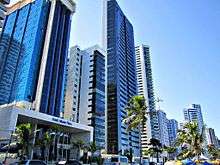
The Recife metropolitan area is the 5th most populous of Brazil, after São Paulo, Rio de Janeiro, Belo Horizonte and Porto Alegre, and the 1st in the Northeast region. The most populous neighborhoods of Recife in 2008 were Boa Viagem (100,388), Casa Amarela (69,134), and Várzea (64,512).[24]
According to the 2010 IBGE Census, there were 1,472,202 people residing in the city of Recife.[25] The census revealed the following numbers: 754,674 Pardo (Multiracial) people (49.1%), 636,864 White people (41.4%), 127,789 Black people (8.3%), 14,696 Asian people (1%), 3,665 Amerindian people (0.2%).[26]
In 2010, the city of Recife was the 9th most populous city in Brazil.[27]
In 2010, the city had 268,160 opposite-sex couples and 1,004 same-sex couples. The population of Recife was 53.8% female and 46.2% male.[26]
Religion
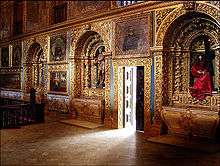
The Patroness Saint of Recife[28] is Our Lady of Mount Carmel (Nossa Senhora do Carmo), dating back one hundred years ago (1909). Every July 16, her day, she is remembered by the Catholics in Recife, in her church.
| Religion | Percentage (%) | Number |
|---|---|---|
| Catholic Church | 54.32 | 835.337 |
| Protestant | 24.99 | 384.303 |
| No religion | 14.59 | 224.401 |
| Spiritist | 3.56 | 54.788 |
| Other Christian religiosities | 1.59 | 24.474 |
| Umbanda, Candomblé and other Afro-religions | 0.48 | 7.434 |
| Judaism | 0.08 | 1.286 |
| Buddhism | 0.04 | 641 |
| Indigenous traditions | 0.01 | 251 |
| Islam | 0.004 | 69 |
| Hinduism | 0.002 | 38 |
Source: IBGE 2010.[29]
Economy
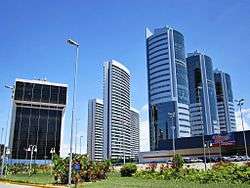
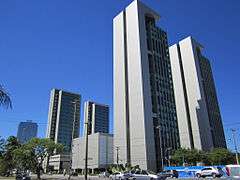
According to 2013 IBGE statistics, the GDP was at R$46,445,339,000. And the GDP per capita was at R$29,037.[30]
Recife is one of Brazil's prime business centers, largely because it has one International Airport and two International ports. One is located in the town itself, and the other, the port of Suape, is located about 40 kilometres (25 mi) away. Just south of Recife is the region's main industrial area, where the following industries can be found: brewing and canning, shipbuilding, automotive, electronics, tube manufacturing, chocolate manufacturing, textiles, etc.[31]
Recife has shared in the prosperity of Northeastern Brazil that resulted from development promoted after 1960 by Sudene (Superintendência para o Desenvolvimento do Nordeste), a federal organization. Although its retail and wholesale trade have grown in response to the region's increases in population and wealth, the market area and the walkways of the city's bridges are crowded with informal traders selling small items.[32]
Information technology industry

Recife has an area dedicated to information technology called "Porto Digital" (Digital Port) with more than 90 companies and 3,000 High Tech Jobs. It was founded in July 2000 and has since attracted major investments. Generating some R$10 billion (Brazilian Reais) a year,[33] it produces technology that is exported to United States, India, Japan, China, among other countries. Software manufacturing is the main activity in the Porto Digital.[34] The Porto Digital cluster comprises small and medium companies, but multinationals like Accenture, Motorola, Samsung, Dell and Sun Microsystems are also installed in Porto Digital. IBM and Microsoft transferred their regional headquarters to Recife.[35]
Porto Digital's startups can count on a ready pool of talent, courtesy of the Federal University of Pernambuco (UFPE), which boasts one of the best computer-science departments in all of Latin America.[36] The school began teaching programmers to use Sun Microsystems Inc.'s (SUNW) Java language in 1996, the year it was introduced. Professors at the school also teamed up to launch Centro de Estudos e Sistemas Avançados do Recife (C.E.S.A.R), a business incubator that has played a vital role in the birth of some 30 companies.[36]
Logistics hub
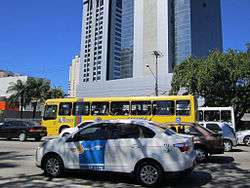

Due to its ports, airport, and geographic location in the northeastern region of Brazil, Recife is considered one of the biggest logistics hubs in Brazil. Logistics and Communications Economic sector employees 4%[37] of the people in Recife, 12,3% in Jaboatão dos Guararapes and over 9% in the Metropolitan Area. These numbers could increase by the end of 2010 with the conclusion of the Transnordestina (main NE Trainline with a 1,800/1,118 km/mi extension, which will cross 3 and connect 7 States (34 municipalities in Pernambuco alone) products with Suape port (PE) and Pecem Port (CE)) with costs that are estimated to be around 4.5 R$.[38]
Recife has historically benefited from its central location in the Northeast region. In a 200-mile (320 km) radius from Recife, it is possible to find four state capitals, two international and three regional airports, five international ports, 12 million people, 51% of the research centers of Northeast and 35% of the region's GDP. Similarly, in a 500-mile (800 km) radius there are seven state capitals, five international and five regional airports, nine international ports and two fluvial ports.
Shopping centers

.jpg)
Shopping Center Recife was inaugurated in 1980 and it was surpassed by Riomar Mall, which gross leasable area is 101.000, against 91.200 of Shopping Recife Mall.
Other shopping centers include:
- Shopping Center Tacaruna. The first center for purchases in the North/West zone of the Recife Metropolitan Region was inaugurated on April 29, 1997, with the intention of improving the economies the cities of Recife, Olinda, and Paulista.[39]
- Shopping Paço da Alfândega
- Plaza Shopping Casa Forte was inaugurated in November 1998.[40]
- Shopping RioMar was inaugurated in 2012.[41]
Medical facilities
The Metropolitan Region of Recife has the 2nd largest medical pool in Brazil, after São Paulo. Together they make up 417 hospitals and clinics with 72,000 employees in the Metro Area and more than 120,000 in the State of Pernambuco. The medical pool offers a total of 8,990 beds and, according to the Union of the Hospitals of Pernambuco, recorded in the year 2000 an invoicing of R$220 million (Brazilian Reals). It is thanks to the pool that Pernambuco has access to more computed tomography devices than more developed countries such as Canada or France.[42]
A large portion of the modern hospitals included in the pool are located between the neighbourhoods of Derby and of the Ilha do Leite. The Hospital Real Português de Beneficência Portuguesa em Pernambuco, or "Hospital Português" (Portuguese Hospital) for short, is one of the most renowned hospitals in the country.[43] Many people from neighbouring states go to Recife for treatment, as it has the largest and best medical facilities in the North–Northeast of Brazil.[44] Recife has three universities for medicine, 2 public, Federal University of Pernambuco and University of Pernambuco; and 1 private, Escola Pernambucana de Medicina FBV/IMIP (Medical School of Pernambuco).
Convention centers
Many events taking place during the year include:
- O Virtuosi, Festival International de Musica de Pernambuco (International Music Festival);
- O Mimo, Mostra International de Musica em Olinda (International Music Show in Olinda);
- A feira da Musica Brasil/Porto Musical (Brasil Music Port);
- A Fispal Recife, Feira Internacional da Alimentacao (International Food Festival);
- Recife and Olinda Carnival.
And because of its geographic location, tourism and city infrastructure, Recife's Convention Centers are of a high standard:
- Centro de Convenções de Pernambuco (Pernambuco Convention Center)
The 3rd largest convention center in Brazil.[45]
- Centro de Convenções da UFPE (Federal University of Pernambuco Convention Center)
Modern theatre with 1,931 seats and 2,071 square metres (22,290 square feet) of exposition area located in the University Campus.
Tourism and recreation
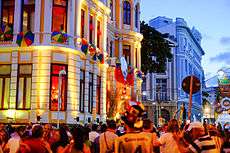

The celebrations, holidays and other events are numerous during the whole year. Thus the New Year begins at the beach, Praia de Boa Viagem and in Old Recife. The carnival of Recife and Olinda (which has its historic town centre considered world heritage site by UNESCO in 1982)[46] begins many weeks ahead in December with innumerable balls and parades.
In the city, the carnival festivities begin in December, as locals begin preparing for the official Carnival, which starts the week before Ash Wednesday. The pre-Carnival parties usually consist of percussion groups practicing in local clubs, city streets and squares, and even Carnival balls. There is a variety of rhythms from different cultures. Carnival officially starts with the Galo da Madrugada, a party in Downtown Recife attracting many people from several States of Brazil, and other parts of the world.
Recife has many quality 3, 4 and 5-Star International Hotels as well Pousadas (traditional Bed & breakfast) and Apart-Hotels totaling more than 11,500 bedrooms and this number increase to over 30,000 in the metropolitan area of Recife.[47]
Mercado de São José (Market of Saint Joseph) is an old, iron construction with a popular market nearby. In the Fort Cinco Pontes (Fort of Five Points) is the state museum, (Museu do Estado de Pernambuco). At the rectangular Pátio de São Pedro are the Cathedral São Pedro (Cathedral of Saint Peter) dating from the year 1782 and restored colonial houses, with numerous restaurants, bistros and bars. In the Bairro Santo Antônio (Saint Anthony Neighborhood), at the meeting place of the rivers Capibaribe and Beberibe, is the Praça da República (Square of the Republic) with the Teatro Santa Isabel (Theatre of Saint Isabel), with its neoclassic front - well worth seeing, the Law Courts, and the Palácio da Justiça (Palace of the Justice). Casa da Cultura (House of Culture) is an old prison that has been converted into a cultural space and shopping centre.
Built between 1835 and 1855, the Malakoff Tower, a monument constructed in Tunisian style, which used to be an observatory and now is a cultural centre and a place for popular gatherings. It is located at Arsenal da Marinha Square. It has been registered as a Historical Patrimony and was named after a similar monument on Crimean peninsula, used as a defence centre for Sebastopol.[48]
Recife has a zoo called Dois Irmãos Park, 387 hectares of Atlantic Forest reserve and 14 hectares of botanical gardens. There are also 800 wild animals, the Natural Science Museum and various ecological trails.[49] The metropolitan area has also a giant water park 20 km (12 mi) North of Recife, called Veneza water park which has nearly one million sq/ft of area, ten millions litres of water and lots of water slides for the youngsters.
Among Recife's main tourist attractions are:
- Churches, historical monuments, public markets including 17th and 18th century constructions from Portuguese and Dutch colonisers;
- Francisco Brennand's atelier of ceramic art;
- Ricardo Brennand Institute: cultural institute with museum, pinacotec and library;
- Recife Antigo (Old Recife) buildings;
- Boa Viagem beach (the inside city's most important beach) and many beautiful beaches in the metropolitan and state area;
- Casa da Cultura: souvenir shops in an Historic prison building;
- The Carnival at locations such as downtown and Recife Antigo;
- Olinda's historic town centre, considered a world heritage site by UNESCO;[46]
- News and Historic Cinemas, Theatres and Art galleries.
Beaches
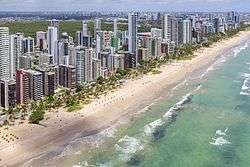
Recife beaches
- Boa Viagem, Pina and Brasília Teimosa
Jaboatão beaches
- Piedade, Candeias and Barra de Jangada
Olinda beaches
- Rio Doce, Casa Caiada and Nossa Senhora do Ó
North beaches
- Janga, Pau Amarelo, Conceição and Maria Farinha (with one of the largest water park in Brazil - Veneza water park (Paulista RMR) 18/29 km N
- Gavoa, Itamaracá and Jaguaribe. Itamaracá Island has many beaches such as Coroa do Avião, Forte Orange, Quatro cantos and Pontal (Itamaracá RMR) 30/45 km N
Education
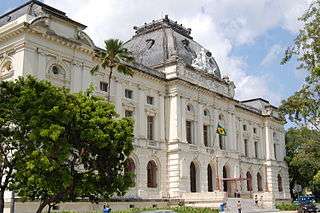
There are international schools, such as the American School of Recife and the ABA Maple Bear Canadian School.
Recife is home to several higher education institutions (83), notably several public-owned universities:
- Universidade Federal de Pernambuco; UFPE (federal, free);
- Universidade Católica de Pernambuco; UNICAP (private, run by the Society of Jesus, paid);
- Universidade de Pernambuco; UPE (state-owned, free);
- Universidade Federal Rural de Pernambuco; UFRPE (federal, oriented to agriculture, free);
- Faculdade Estácio do Recife (former Faculdade Integrada do Recife); FIR (private, paid);
- Faculdade Marista do Recife; FMR (private, run by the Marist congregation, paid)
- Faculdade SENAC Pernambuco (private, paid);
- Centro Universitário Maurício de Nassau; UNINASSAU (private, paid)
- Instituto Federal de Educação, Ciência e Tecnologia de Pernambuco; IFPE (technological college, federal, free);
- Faculdade de Tecnologia de Pernambuco; FATEC-PE (technological college, state-owned, free).
Culture
Recife is the home of several artists, musicians and writers. It is also home to the frevo, a regional dance and music, typical in carnival, and Mangue Beat, a type of Brazilian rock with mixture of Maracatu, Ciranda, Rap and other musical styles. The Festival de São João, held annually in June, celebrates traditional culture and music that originated in the region. Abril Pro Rock, held every April, showcases contemporary rock music.
During carnival, downtown Recife holds one of the most authentic and democratic celebrations: every year more than one and a half million people open the festivities of the Brazilian Carnival at Galo da Madrugada. Recife and Olinda combined[50] have 25 museums, 38 art galleries, 2 Orchestra houses, 15 theatres, 1 opera house and more than 40 movie theatres.
Carnival

.jpg)
The four-day period before Lent leading up to Ash Wednesday is carnival time in Brazil. Rich and poor alike forget their cares as they party in the streets. Pernambuco has large Carnival celebrations with more than 3000 shows in the street historic centre performed for over than 430 local groups, including the Frevo, typical Pernambuco music. Another famous carnival music style from Pernambuco is Maracatu. The cities of Recife and Olinda hold the most authentic and democratic carnaval celebrations in Brazil. The largest carnival in Brazil is Galo da Madrugada, which takes place in Downtown Recife on Carnival Saturday. Another famous event is the "Noite dos Tambores Silenciosos." Carnival Recife's joyous Carnival is nationally known, attracting thousands of people every year.
The party starts a week before the official date, with electric trios "shaking" the Boa Viagem Neighborhood. On Friday, people take to the streets to dance to the sound of frevo and to dance with maracatu, ciranda, caboclinhos, afoxé, reggae and manguebeat groups. There are still many other entertainment poles spread out around the city, featuring local and national artists. One of the highlights is Saturday when more than one and a half million people follow the Galo da Madrugada group.[51] Everyday, there is the Night of the Silent Drums, on the Pátio do Terço, where Maracatus honor slaves that died in prisons.[52]
"Frevo" was born from the confluence of European and Afro-Brazilian cultures,[53] as probably did all the other musical genres consolidated in Brazil. Historians from Pernambuco say that, before the term appeared in Recife's 'Jornal Pequeno', it was already heard and danced in a symbiosis of polkas, 'modinhas', 'dobrados' e 'maxixes' e 'jogos pastoris' (stick and rope formations) along the streets of Pernambuco's capital.[54]
The music bands (civilian or military) of the time helped giving the sound the defining character we have come to know as the Frevo, a musical mass defined by the brasses. About the Street-Frevo, conductor Guerra Peixe said once that "it is the only popular genre that does not admit the 'play-by-ear composer'. He was referring to the technical hardship of this kind of music, and stressing the role of conductors who led the 'frevistical' troupes.
Museums

The Museum of Pernambuco State was housed in a 19th-century mansion in Recife, the "Museu do Estado de Pernambuco (MEPE)" dates back to 1929. From Masters who portrayed the Colonial period, as well as the Dutch invasion (1630) to 20th and 21st century, the museum comprises over 12 thousand art pieces.
Sinagoga Kahal Zur Israel, the historic Recife synagogue in Recife Antigo, is the oldest in the Americas, dating to 1646. The original synagogue was destroyed, but a new one was built on site. In the 21st century, it was restored for use as a museum. It is an important part of Pernambuco's historic patrimony. It was founded by Jews who settled in the Netherlands after expulsion from Spain and Portugal. They emigrated with the Dutch to "New Holland" when the Dutch invaded the northeastern portion of Brazilian lands occupied by the Portuguese. When the Portuguese reconquered the land, these Sephardic Jews moved further north with the Dutch, and helped found "New Amsterdam" (now New York City) on Manhattan Island.[55] The first New York City synagogue was created in Lower Manhattan by the founders of the first synagogue in the New World in Recife. It later moved to the Upper West Side, where it is still called "The Portuguese and Spanish Synagogue".
Gilberto Freyre Foundation This farmhouse from the 18th century was Gilberto Freyre's old residence. Artworks, arts and crafts, book collections and objects that belonged to the Pernambucan writer and sociologist are displayed here.
Ricardo Brennand Institute Set up in a reproduction of a medieval-style castle, there is a collection of pieces from the period of Dutch rule in Recife, as well as daggers and armor from medieval Europe.
Recife City Museum Located in a room in Cinco Pontas Fort (the five-pointed Fort), it houses pictures, reproductions of old paintings, and objects that encapsulate Recife since the period of Dutch rule.
_-_Recife_-_Pernambuco_-_Brasil.jpg)
Cinema
Also known as Recife Audiovisual Festival or Cine-PE, Recife Cinema Festival is a competitive film and audiovisual festival that is held in Recife. It is dedicated to the Brazilian and state production of feature & short films; as well as videos and documentaries. It was founded in 1997 by the Alfredo & Sandra Bertini, who have been the directors since then. Between 1997 and 2008, 1806 films [57] (through either competitive applications or National & International invitations) of all types and genres for a public of over 250,000 people have been a part of it.
Recife and consequently Pernambuco has a tradition in the Brazilian film making history. In the pioneer times of the Brazilian cinema emerged the Regional movements. One of those, was designated Ciclo de Recife[58] (Recife cycle), between 1922-1931. Despite adverse conditions, during this cycle was realised in Recife 13 feature films (usually about drama & Romance) and 7 realistic films (usually ordered by authorities to show their public works). Despite pervasive influence of U.S. and European cinemas in the silent film times, the Recife cycle was one of the most important, regional and productive of them. One of the most important movie was Aitaré da Praia, which is recognised for pioneering the rise of regional themes (1925). Another large successful films was Retribuição (1923) and A Filha do Advogado (1926). Another important phase of the Pernambuco/Recife film history was in the 1970s with a movement called Super 8, often used for home videos and documentaries realised by students, curious and aspirant film makers, due to the utilisation of 8 mm film, proportionated by the new technology released by Kodak.[59]
Cuisine


Recife cuisine is the cuisine of its region, Pernambuco and the Northeast, and the culinary influences of the area can be traced to a dynamic assortment of cultures: the Portuguese, Dutch, Spanish, Moors, Africans and Indigenous.[60] Many dishes come with a delicious coconut sauce, palm oil (dendê) and feature corn, manioc roots, yam, fresh seafood (shrimp, crab, lobster cooked with exotic sauces) and native fruits. Grilled meats are also big here, especially goat and beef dishes.[61]
The typical regional main dishes include caldeirada (seafood stew with octopus cooked with various spices and coconut milk, may be served with white beans or farofa), feijoada Pernambucana (made with brown beans instead of black), sarapatel, buchada (goat stew), dobradinha (bean stew), roast goat, mão de vaca (cow's foot stew), Rabada (ox tail stew with manioc flour), cozido Pernambucano (beef stew), chambaril, galinha de cabidela (chicken in blood sauce), peixada Pernambucana (fish stew), macaxeira com charque (cassava with beef jerky), quiabada (okras with beef), feijão com arroz (rice and beans), guaiamuns (giant crabs) and one of the most traditional dish, is Carne-de-sol (Sun-dried beef), which consists of beef dried in the sun and usually served with green beans.[62]
For dessert, it has bolo de rolo (cake roll), cake Souza Leão, cartola (top hat cake) which consists of fried long bananas with cheese topped with cinnamon and sugar. The diversity continues for the breakfast as one person can find cuscuz of sweet corn or manioc, yams and cassava with charque (corned beef or beef jerky), sweet potato, goiabada, fried long banana, mugunzá, regional fruits, bread, tapioca, rice pudding, porridge, yogurt, queijo coalho, corn bread, hominy and pamonha. This meal is often accompanied by coffee and/or milk and juices from regional fruits such as cashew, pineapple, mangoes, acerola, guava, passion fruit, umbu, hog plum, pitanga, jackfruit, orange, avocado and the regional most famous caldo-de-cana and água-de-coco juices.[63]
According to Abrasel (Brazilian Association of Bars & Restaurants), Recife has more than 1,700 bars and restaurants which serve regional (partially listed above), Brazilian (such as moqueca, bobó de camarão, açaí) and International dishes from all over the world, which has made it the first gastronomic pole of the Northeast[64] and the third one in the whole country after São Paulo and Rio.
Transportation
International airport
Guararapes International Airport, also known as Gilberto Freyre International Airport, is the airport serving Recife. It has been open in its newest structure since July 2004 and is 52,000 square m in area.
Ports
Suape port, is located in the administrative area of the small town of Ipojuca, inside the metropolitan region. Suape serves ships 365 days a year without any restrictions with regard to tidal schedules. The port moves over 8.4 million tons of cargo a year. More than 95 Companies[65] from almost all Industries are already installed in Suape which includes a Petrobras Refinary, the largest Ship Builder in South American and a large Petrochemical Company as many others. Port of Recife is located in the city of Recife. Road access to Port of Recife is accomplished, mainly, through the federal highways BR-232 (linking the interior of the state) and BR-101 (linking to other States to the north and the south of the State of Pernambuco). The main producing and consuming centres of the interior of the state and of the rest of the Northeast, are linked to Port by paved highways.
Metro
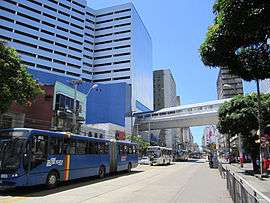

Recife Metro is one of the largest metro systems in Brazil. It reaches from Recife central station to Jaboatão, Timbi (Camaragibe) and Cajueiro Seco (Jaboatão dos Guararapes), being complemented by a light rail, with integrations in Curado and Cajueiro Seco stations, which links Recife and Jaboatão to Cabo de Santo Agostinho.
This system also integrates with several bus lines connected to the bus/metro[67] integration terminals, such as Barro, Joana Bezerra and Tancredo Neves stations. It is possible to ride the metro and the connected bus line by purchasing one ticket only. Since March 2009, Recife Metro has finished one more phase of expansion. The system now has 29 stations (18 integrated with buses), plus 9 light rail stations, and is 39.5 km (24.5 mi) long.
Fleet
According to Detran-PE (Transportation State Bureau Administrator) in 2009, the city of Recife had a total fleet of over 464,000[68] motor vehicles on its streets. 54,335 cargo vehicles, 318,520 passenger vehicles, 72,719 motorbikes, 14,142 others and 4,855 buses (split between private and public). These buses transport almost two million passengers daily[69][70] in the metropolitan area, distributed between 17 local bus companies.
Highways
Recife metropolitan area is crossed by 3 main Federal highways:[71]
- BR-101 North - Paraíba and Rio Grande do Norte;
- BR-101 South - Alagoas, Bahia, Minas Gerais, Rio de Janeiro, São Paulo, Paraná and Rio Grande do Sul;
- BR-232 West - Gravatá, Caruaru, Belo Jardim, Arcoverde, Salgueiro and Parnamirim;
- BR-408 NW - Carpina, Timbaúba and Campina Grande;
Neighborhoods
The city has 6 Regions[72] Political Administrative RPA, which contains all 94 neighborhoods:
- Aflitos, Afogados, Água Fria,
- Alto do Mandu, Alto José Bonifácio,
- Alto José do Pinho, Alto Santa Terezinha,
- Apipucos, Areias, Arruda, Barro,
- Beberibe, Boa Viagem, Boa Vista,
- Bomba do Hemetério, Bongi,
- Brasília Teimosa,Brejo da Guabiraba,
- Brejo de Beberibe,Cabanga,Caçote,
- Cajueiro, Campina do Barreto,
- Campo Grande, Casa Amarela,
- Casa Forte,Caxangá,Cidade Universitária,
- Coelhos, Coqueiral, Cordeiro,
- Córrego do Jenipapo,Curado, Derby,
- Dois Irmãos,Dois Unidos,Encruzilhada,
- Engenho do Meio,Espinheiro,Estância,
- Fundão, Graças, Guabiraba,
- Hipódromo,Ibura,Ibura de Cima (Cohab),
- Ilha do Leite, Ilha do Retiro,
- Ilha Joana Bezerra,Imbiribeira,Ipsep,
- Iputinga, Jaqueira, Jardim São Paulo,
- Jiquiá, Jordão, Jordão Baixo,
- Linha do Tiro,Macaxeira, Madalena,
- Mangabeira, Mangueira, Monteiro,
- Morro da Conceição, Mustardinha,
- Nova Descoberta, Passarinho,
- Paissandu, Parnamirim, Pau Ferro,
- Peixinhos, Pina, Poço,
- Ponto de Parada, Porto da Madeira,
- Prado, Bairro do Recife (Recife Antigo),
- Rosarinho, San Martin, Sancho,
- Santana, Santo Amaro, Santo Antônio,
- São José, Sítio dos Pintos,
- Soledade, Tamarineira, Tejipió,
- Torre, Torreão, Torrões,
- Totó, Várzea,
- Vasco da Gama, Zumbi .
 The neighborhood of Ilha do Leite.
The neighborhood of Ilha do Leite. Bicycle path in Boa Viagem neighborhood.
Bicycle path in Boa Viagem neighborhood. The neighborhood of Pina.
The neighborhood of Pina.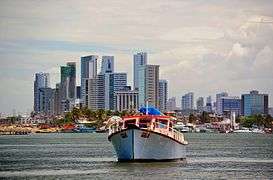 The neighborhood of São José.
The neighborhood of São José. Sculptures Park.
Sculptures Park. Historic buildings in Old Recife.
Historic buildings in Old Recife. Visconde de Jequitinhonha Avenue.
Visconde de Jequitinhonha Avenue. Mascarenhas de Morais Avenue.
Mascarenhas de Morais Avenue._-_Brasil.jpg) The neighborhood of Boa Viagem.
The neighborhood of Boa Viagem. The neighborhood of Santo Antônio.
The neighborhood of Santo Antônio. The neighborhood of Boa Vista.
The neighborhood of Boa Vista.
Sports
Football in Pernambuco began in 1902, when English and Dutch sailors landed in Recife and played a game of football on the beach. The new game aroused the interest of the people of Pernambuco, and they soon started playing.
Recife provides visitors and residents with various sporting activities. There are several football clubs based in Recife, such as Sport the current 2014 State Champion (40 times state champion and once national champion (1987) and Brazil's Cup champion (2008)), Santa Cruz (29 times state champion) and Náutico (21 times state champion and unique 6 consecutives). The Campeonato Pernambucano (Pernambuco's State Championship) is divided into Taça Revolução and Taça Confederação. They both have the same format: standard round-robin, in which all teams play each other once. A round-robin tournament or all-play-all tournament is a type of group tournament in which each participant plays every other participant an equal number of times. If a team wins both Taça Tabocas e Guararapes and Taça Confederação do Equador, it is crowned the state champion. If not, a home-and-away playoff with the winners is disputed, and the winner is declared the state champion.
Also, the city has traditions in another sports as: Basketball, Hockey, Golf, Tenis, Table tenis, Volleyball, beach volley, Handball, Surf, Skateboard, Bodysurf, Swimning pool and Futsal. Provided by clubs such as: Nautico, Sport, Santa Cruz, Portuguese Club of Recife, Caxanga Golf & Country Club, Mauricio de Nassau University, School of Tenis Recife as others.
1950 and 2014 FIFA World Cup
.jpg)
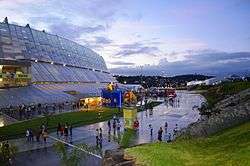
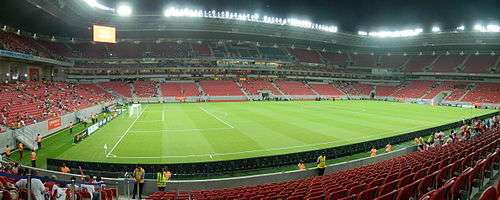
Recife was one of the 12 cities to host games for the 2014 FIFA World Cup, for which Brazil was the host nation. The Metropolitan Recife project consists of a new Sports City to be built in São Lourenço da Mata in an intersection area near to Recife, Jaboatão dos Guararapes and Camaragibe. The new Sports complex is 19 km (12 mi) west of Recife city centre and 19 km (12 mi) from the Airport.
The sports complex 'City'[73] will have a new stadium (Arena Cidade da Copa) with 45,000 seats, 9,000 flats, 6,000 car parking spaces, 1 hospital, 1 technical school, 1 shopping centre, 1 integrated metro/bus station and improvement of federal roads, all with an estimated cost of R$1.6 billion. Further expenses will be necessary in the metro area for remodelling of roads and airport expansion.
This was the second time Recife has been chosen to be one of the host cities of the FIFA World Cup. In 1950, Recife hosted just one game in the Brazil World Cup between Chile and the United States, at Ilha do Retiro Stadium. At this time, it was the only city which represented the Northeast of Brazil.
Social and environmental issues
Violence

.jpg)
In 2013, Recife had the 38th highest homicide rate in The Americas, after Detroit, New Orleans, Baltimore, San Juan and other cities.[74]
PESP plan
The State Governor Eduardo Campos introduced the PESP plan (Security state Plan - Plano Estadual de Seguranca Publica) on second of May 2009, which will try [75] to reduce homicides by 12% each year until they reach half of the previous rate. The plan is based on the fact that 60% of the murders are committed by people related to criminal activities and reaches from the prevention stage until the correctional stage.
Carnival security plan
ISS servers managed 50 Pelco Spectra PTZ cameras to capture all activity within the city's celebratory areas. Continued deployment of this project at Recife will continue towards a short-term goal of over 1000 cameras blanketing the city. Immediate statistics during the Carnival period indicate a reduction in violent crime of over 30%.[76][77]
Recuperation program
UNICEF is an international development agency, which supports locally initiated projects with an emphasis on children. Recife offered an environment to utilise its rich cultural heritage to develop programs aimed at its most serious issues. One of the most hands-on projects was a radio program named "Jovens Comunicadores" (Communicating Youth).[78] It trained a group of eighteen adolescents to produce a weekly radio program focusing on child labour. The program is recorded and sent to community radio stations, most of which are broadcast in the sugar cane area where many children work. Jovens Comunicadores advocates and lobbies against exploitation, all produced and edited by teens. As a radio program, it also plays regional music, giving a boost to local culture.[79]
"Criança Feliz" (Happy Child) had the same objective, eliminating child exploitation, but used a different approach. It was begun by a women's organisation and offered after-school activities with the goal of discouraging children and adolescents from working in sex tourism. Besides giving classes and training in computers, English, art, and karate, it also offered psychological services and group therapy. These combined services sought to equip children not only with skills but also a positive self-image and respect to not fall into prostitution. As all the kids came from very poor backgrounds, the financial pull of prostitution is very high. Criança Feliz worked at educating them about the high costs in the long term. This was a very interesting project, since it was actually a house with groups of kids divided into participating in different activities.[80]
Shark attacks
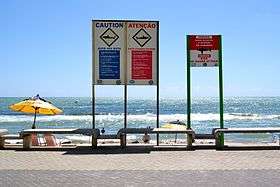

Shark attacks were addressed in the National Geographic Channel series Hunter Hunted in the episode "Shark Invasion." Surfing has been outlawed since 1995 on the urban beaches (Pina, Boa Viagem, Piedade, and Candeias) because of the risk the sport poses to its practitioners due to shark attacks. It is strongly recommended that bathers not climb over and swim beyond the reefs because of strong, unpredictable currents and the possible presence of bull sharks. Several beaches have messages alerting people to the danger of meeting sharks, although this is very rare, as in most parts of Brazil.[81]
Before the 1990s there were virtually no attacks reported here, but since 1992 there have been 59 shark attacks along a 20 km (12 mi) stretch of coast; 24 of them were fatal.[82]
Scientists believe most of these attacks are committed by two species, bull sharks and tiger sharks, but forensic evidence has only been able to confirm the species responsible in eight of these attacks. Bull sharks are considered to be one of the most dangerous shark species, with many proven attacks against humans. There are almost two million people in Recife and surrounding areas, and there are many beaches conveniently located in and around the city, but some 700 metres (2,300 feet) off the coast lies a deep trench running parallel to the beaches near the city. Sharks use this trench as a migratory route and emerge from it to hunt in the shallows.
It is Recife's Port Suape, though, that many see as the biggest cause of the recent attacks. Located 20 kilometres (12 miles) south of Boa Viagem Beach, where most of the attacks have occurred, the port has been the cause of much disturbance for marine life along the coast and the nearby estuaries. To facilitate its initial construction, in the late 1970s, two freshwater estuaries which had discharged into the Atlantic Ocean were sealed off. The port opened for business in 1984, (and today handles more than four million tonnes of cargo per year) but it was not until 1992 that it began to attract significant shipping traffic. Before 1992, Recife had no more shark attacks than any other beach in Brazil, but the change was immediate and dramatic.
To build the port, estuaries were dredged and long docks built, protruding out into the ocean. This is especially a problem for bull sharks, who generally stay close to land and are able to tolerate fresh water (they are regularly encountered in rivers such as the Amazon). Much of their life cycle is dependent on coastal estuaries and the building of Suape is thought to have disrupted breeding and hunting habits.
Cemit, the Council for Shark Hazard Monitoring, conducts a catch-and-release program to remove the sharks from beaches. 81 sharks were caught, tagged with tracking devices, and released far out to sea. Its GPS data on the sharks tagged show that after being caught, all tiger sharks have migrated to other regions. To get the sharks further out to sea, Cemit in 2006 sank three boats on the far side of the ocean trench to create an artificial reef. This was to attract fish to congregate around the boats so that sharks coming out of the trench to hunt would move away from the beach.[83]
The state-funded investigation has focused on the long-term ecological effects of the new port of Suape. Based on its findings, local human rights lawyers are considering a symbolic legal challenge to the State of Pernambuco, with the aim of securing compensation for the victims of attacks.
Notable people

- Mário Schenberg, physicist, electrical engineer, art critic and writer.
- Paulo Freire, educator and philosopher.
- José Leite Lopes, physicist.
- Clarice Lispector, writer.
- Paulo Ribenboim, mathematician.
- João Cabral de Melo Neto, poet and writer.
- Leopoldo Nachbin, mathematician who is best known for Nachbin's theorem.
- Gilberto Freyre, sociologist, poet and writer.
- Gauss Moutinho Cordeiro, mathematician.
- Josué de Castro, humanist and writer.
- Aron Simis, mathematician.
- Norberto Odebrecht, entrepreneur from the Building Industry.
- Nelson Rodrigues, poet and writer.
- Manuel Bandeira, poet and writer.
- Joaquim Nabuco, writer, journalist and diplomat.
- Romero Britto, sculptor and painter.
- Francisco Brennand, sculptor, painter and ceramist.
- Andree Guittcis, jewelry designer.
- Karol Meyer, free-diver.
- Jaqueline Carvalho, professional volleyball player.
- Dani Lins, professional volleyball player.
- Juninho Pernambucano, footballer.
- Hernanes, footballer.
- Vavá, footballer.
- Rivaldo, footballer.
- Junior Assuncao, mixed martial artist.
- Braulio Estima, Brazilian jiu-jitsu practitioner.
- Robyn Regehr, ice hockey player.
- Eduardo Campos, economist and politician.
- Marco Maciel, lawyer and politician.
- Cristovam Buarque, mechanical engineer, economist and politician.
- Marco Nanini, actor.
- Guilherme Berenguer, actor.
- Bruno Garcia, actor.
- Rebecca Da Costa, actress.
- Virginia Cavendish, actress.
- Patrícia França, actress.
- Kleber Mendonça Filho, movie director.
- Heitor Dhalia, movie director.
- Marcelo Gomes, movie director.
- Arlindo Grund, television presenter and personal stylist
- Clarice Falcão, actress and singer-songwriter.
- Naná Vasconcelos, composer and musician.
- Lenine, singer-songwriter.
- Alceu Valença, singer-songwriter.
- Chico Science, singer-songwriter.
- Bezerra da Silva, singer-songwriter.
- Nelson Ferreira, composer and musician.
- Antônio Maria, composer.
- Fred Zero Quatro, singer-songwriter.
- Walter Wanderley, organist and pianist.
Twin towns – Sister cities
| Country | City | State / Region | Since |
|---|---|---|---|
| 1987 | |||
| 2003 | |||
| 2007 | |||
| 1900 | |||
| 1948 | |||
| - |
References
- ↑ Cities Influence Areas
- ↑ IBGE 2012 Census Population
- ↑
- ↑ Recife Municipal Profile
- ↑ Recife Medical Pool
- ↑ Pernambuco A-Z
- ↑ Pernambuco Daily
- ↑ Unesco - Fernando de Noronha Islands
- ↑ Marley, D. (2005). Historic Cities of the Americas: North America and South America. 2. ABC-CLIO. p. 683. ISBN 978-1576070277.
- ↑ Banner, J.C. (1904). "The Stone Reefs of Brazil, their Geological and Geographical Relations". Bulletin of the Museum of Comparative Zoology. Harvard College, Cambridge. XLIV.
- ↑ Weather of Recife
- ↑ GDN 2012
- 1 2 "Temperatura Média Compensada (°C)" (in Portuguese). Brazilian National Institute of Meteorology. 1961–1990. Archived from the original on May 4, 2014. Retrieved August 1, 2014.
- 1 2 "Temperatura Máxima (°C)" (in Portuguese). Brazilian National Institute of Meteorology. 1961–1990. Archived from the original on May 4, 2014. Retrieved August 1, 2014.
- 1 2 "Temperatura Mínima (°C)" (in Portuguese). Brazilian National Institute of Meteorology. 1961–1990. Archived from the original on May 4, 2014. Retrieved August 1, 2014.
- 1 2 3 "Precipitação Acumulada Mensal e Anual (mm)" (in Portuguese). Brazilian National Institute of Meteorology. 1961–1990. Archived from the original on May 4, 2014. Retrieved August 1, 2014.
- ↑ "Número de Dias com Precipitação Mayor ou Igual a 1 mm (dias)". Brazilian National Institute of Meteorology. Archived from the original on May 4, 2014. Retrieved August 1, 2014.
- ↑ "Insolação Total (horas)". Brazilian National Institute of Meteorology. Archived from the original on May 4, 2014. Retrieved August 1, 2014.
- ↑ "Umidade Relativa do Ar Média Compensada (%)". Brazilian National Institute of Meteorology. Archived from the original on May 4, 2014. Retrieved August 1, 2014.
- ↑ "Temperatura Máxima Absoluta (ºC)". Brazilian National Institute of Meteorology (Inmet). Archived from the original on June 21, 2014. Retrieved August 1, 2014.
- ↑ "Temperatura Mínima Absoluta (ºC)". Brazilian National Institute of Meteorology (Inmet). Archived from the original on June 21, 2014. Retrieved August 1, 2014.
- ↑ Islands of Recife
- ↑ Rivers of the city
- ↑ Recife City Hall - Demographics
- ↑ 2010 IGBE Census (Portuguese)
- 1 2 2010 IGBE Census (Portuguese)
- ↑ The largest Brazilian cities - 2010 IBGE Census (in Portuguese)
- ↑ http://oglobo.globo.com/cidades/mat/2009/07/16/fieis-lotam-igreja-do-carmo-em-recife-para-homenagear-padroeira-da-cidade-756845527.asp
- ↑ Sistema IBGE de Recuperação Automática - SIDRA
- ↑ Recife - produto interno bruto dos municípios - 2013 (Portuguese)
- ↑ Economy of Recife
- ↑
- ↑ Digital Port of Recife (PDF) (in Portuguese). Recife, Brazil: Porto Digital. 2006. ISBN 85-240-3919-1. Retrieved 2007-07-18.
- ↑ Recife Economy - Information on Business and Investment in Recife
- ↑ http://www.eclac.cl/publicaciones/xml/0/43290/Chapter_V._Foreign_direct_investment_in_the_software_industry_in_Latin_America.pdf
- 1 2 Brazil: A Hot Incubator For Tech Startups
- ↑ Government State Site
- ↑ State site Portal Pernambuco, World Cup 2014 Plan, page 11
- ↑ Shopping Tacaruna
- ↑ Plaza Shopping Casa Forte
- ↑ Shopping RioMar
- ↑ Recife Medical Pool
- ↑
- ↑ Medical pool Ranking (PDF) (in Portuguese). Recife, Brazil: UOL. 2006. ISBN 85-240-3919-1. Retrieved 2007-07-18.
- ↑ Convention Centre of Recife (Portuguese)
- 1 2 Olinda - Unesco
- ↑ Miolo_1.pdf Fifa 2014 - Recife
- ↑ Study Guides, Reference Materials for Science, Literature, History & more - eNotes.com
- ↑ Dois Irmãos Park
- ↑ Miolo_1.pdf Cultura in Fifa 2014 project page 23
- ↑ Carnival in Recife (English)
- ↑ Maracatu in Recife (English)
- ↑ Frevo
- ↑ Frevo in Recife (English)
- ↑ History Timeline of Jewish People in America |AllJewishLinks.com
- ↑ Museu foi eleito o melhor da América do Sul pelo site turístico TripAdvisor. (Portuguese)
- ↑ Recife cinema festival
- ↑
- ↑ Study Guides, Reference Materials for Science, Literature, History & more - eNotes.com
- ↑ Cuisine of Recife
- ↑ Recife - Pernambuco
- ↑ oriettagggo - Articles and posts about oriettagggo from the best blogs
- ↑ Recife City Guide
- ↑ Cuisine of Recife
- ↑ Port of Recife (English)
- ↑ Qual é o maior metrô do Brasil? (Portuguese)
- ↑ Recife Metro (in Portuguese). Recife, Brazil: CBTU. 2006. ISBN 85-240-3919-1. Archived from the original (PDF) on 2008-02-02. Retrieved 2007-07-18.
- ↑ http://www.detran.pe.gov.br/download/estatistica/Frota%20registrada%20segundo%20o%20tipo%20-%20Recife.pdf
- ↑ http://blogs.diariodepernambuco.com.br/tecnologia/?p=2229
- ↑ NE10
- ↑ Distancias, Imagens de Satélite, Roteiros, Mapas, Enderecos
- ↑ Prefeitura do Recife
- ↑ Recife Sports City 2014 in Pernambuco State site (Portuguese)
- ↑ Por tercer año consecutivo, San Pedro Sula es la ciudad más violenta del mundo
- ↑ Miolo_2.pdf PESP plan in Fifa 2014 project page 26
- ↑ Security plan of Recife
- ↑ City hall website - Security plan
- ↑ Jovens Comunicadores in Recife, Pernambuco
- ↑ Jovens Comunicadores Program Blog
- ↑ Criança Feliz Program
- ↑ Shark attacks in Recife (Portuguese)
- ↑ Total of fatal shark attacks in Recife (Portuguese)
- ↑ The beautiful Brazilian beaches plagued by shark attacks (English)
- ↑ "Mayor's International Council Sister Cities Program". Recife, Pernambuco. Archived from the original on July 24, 2008. Retrieved 2008-08-18.
- ↑ "Guangzhou Sister Cities [via WaybackMachine.com]". Guangzhou Foreign Affairs Office. Archived from the original on 24 October 2012. Retrieved 2013-07-21.
External links
- (Portuguese) Official homepage
- Eyes On Recife (Recife news & culture)
- Compartilhe Recife (Recife travel tips)
.jpg)



